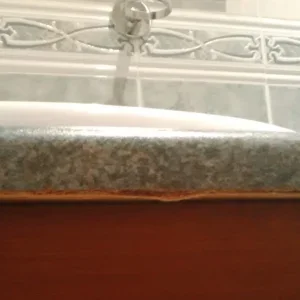Manufacturers offer a wide range of solid colours, photo-finishes of marble, leather and wood grain. These can be particularly effective when pressed onto a panel with an etched platen that mimics the roughness of the real material being simulated. A vast number of textured finishes can be combined with many different colours and so the complete range is enormous – and growing all the time. This flexibility has contributed to the success of particleboard furniture as it has given designers the opportunity to use their imaginations to the full.
The base papers are normally made from chemical pulps because the chemical process removes most of the lignin which would otherwise cause the paper to yellow with age. The laminating paper consists of several layers: Kraft which is strong, a decor which has the printed image, and a thin overlay of almost pure cellulose. The grammage of the laminating paper varies between 100-150g/m².
The laminating paper is impregnated with resin as a continuous roll by dipping the paper into one or two vats of resin and then drying and cutting it in to sheets. Figure 1 shows the paper being passed through a vat in the foreground and then in to the long dryer. The resins are usually melamine and/or urea formaldehyde, melamine being more heat resistant.
As can be seen in the photograph, the dryers are often very long, up to 65m in fact. The paper floats through the dryer as it is suspended by air jets that are orientated to carry the paper through. The paper travels through quickly, at around 70m/min, but speeds can be as high as 120m/min with new machinery, in some circumstances. The drying temperature is carefully controlled down length of the dryer as the aim is to dry the resin but not to cause too much curing (polymerisation) because the resin is needed in order to stick the paper to the panel.
The amount of resin absorbed depends on glue characteristics such as viscosity and solids content and on paper properties such as grammage and thickness, as well as process parameters such as line speed.
The papers are bonded to the panels by positioning them on the faces and pressing them in a short-cycle hot press. A platen temperature of around 205°C is applied for about 18 seconds. The resin in the paper initially melts and flows on to the panel surface and then hardens to bond the paper firmly to the face. The resin remaining in the paper also hardens to give a scratch- and heat-resistant surface.
Thin papers are cheap but require excellent panel surfaces, otherwise colour variations and surface roughness on the panel will change the aspect of the finished product. Thick papers cover surface imperfections and can provide richer colours, but are more expensive.
The term ‘telegraphing’ is applied to the problem caused by the differential swelling of particles in the surface of a panel showing through the paper finish. Obviously, this is less of a problem if small, consistently sized particles are used on the panel surface. It also explains why it is not a good idea to apply a paper laminate to a product like OSB, which has very large surface particles and large gaps between them.
MFC has a good future as the technology continues to develop, permitting new designs and lower production costs. To paraphrase a well-known mobile phone company’s advertising slogan “The future is bright – the future is multi-coloured and textured”!






